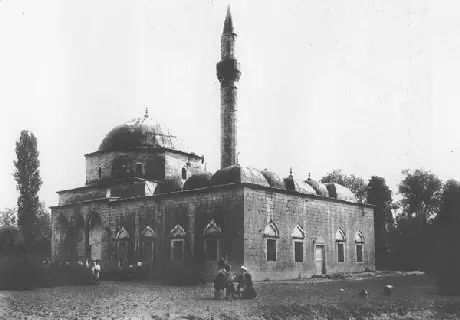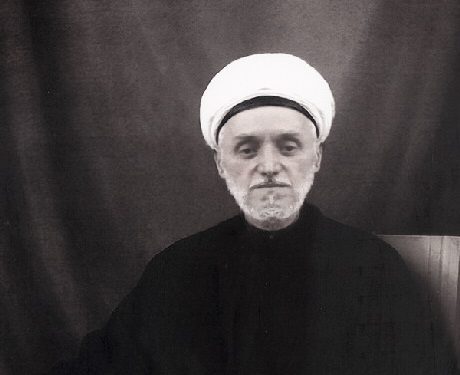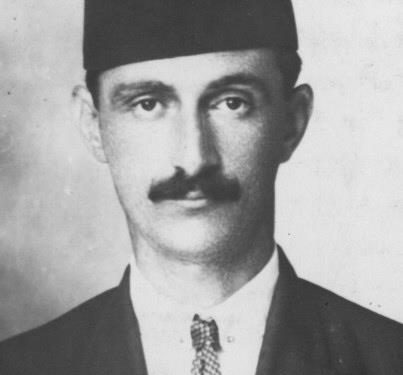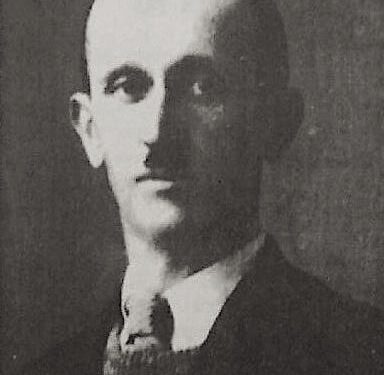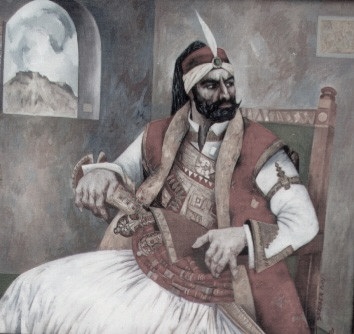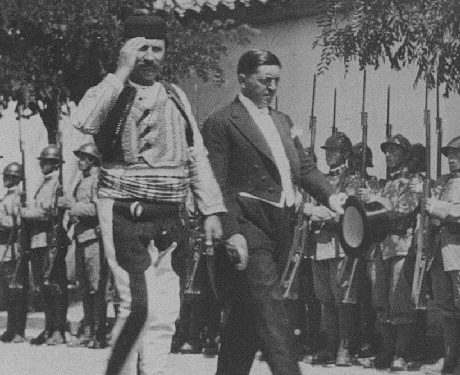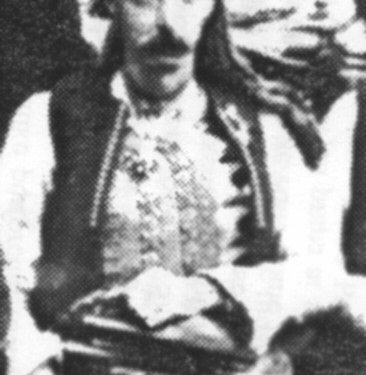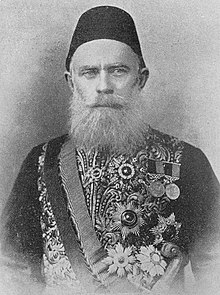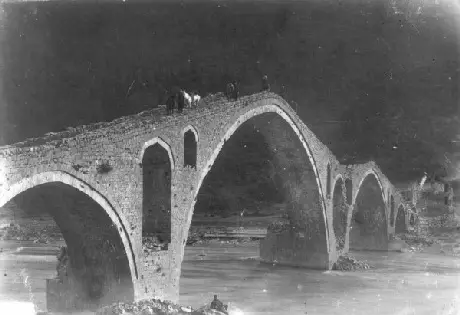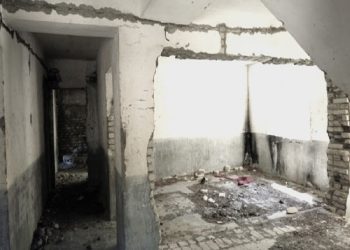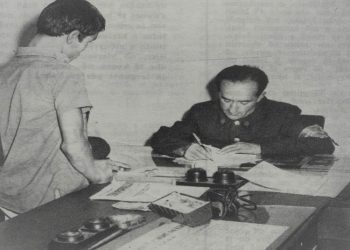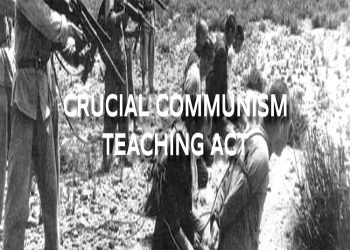By Anila Dushi
– The unknown history of the Bushati dynasty, with three shot, 15 prisoners, and 6 fugitives, as “enemies of the people”, but also with partisans of “Martyrs of the Fatherland”, colonels and first secretaries of the Party Committees districts, which produced 88 teachers and pedagogues, 15 doctors, 74 with higher education and 17 athletes, where today there are 180 families in Shkodër and dozens in the five continents –
Memorie.al / Bushatllinj are among the largest tribes in Shkodër. This feudal family of Albanian origin is well known in Shkodër, since the 15th century, for its tradition of ruling and influencing the city and the province. From this great family from Shkodra, after the period of the Viziers and until the late decades, came the leaders of the people, whether in cases of revolts or during battles for the defense of the homeland. Hysen and Jusuf Begu, are both exponents of the popular uprising called “Hamz Kazazi Uprising” in 1834, their grandson, Selimi i Tahir Begu, took an active part in the war of Miletus and in the League of Prizren. Reshit Begu, participated as the leader of the Shkodra detachments, in the wars against Montenegro in 1876 and was decorated for his bravery. Beqir Begu, the leader of the Shkodrans, in the battle of Shpuza, alongside Dasho Shkreli
The Albanian people have sung songs of bravery to these men. Shaban Begu, the son of Ali Begu, stood out as a warrior of the League of Prizren, as the song of the Tivari castle shows, as he was the leader of the Shkodra warriors who fought for the defense of this castle. Shaqir Begu, Shabani’s son, led the Shkodran detachment in the “Military War”, and fought bravely in Rrzhanica alongside Dede Gjo Lulin, against the Montenegrins. Xhemal Shaqir Bushati and Visho Bushati gave their contribution as patriots, before the declaration of independence, and were later elected by the people, deputies and members of the municipal assembly. On the stage of Albanian politics, Sylço Begu (Bushati) appears in the ‘Koplik War’ and Maliq Bushati, deputy, minister and prime minister in the years 1941-1943. This tribe also includes the well-known clerics: Haxhi Haliti, Molla Rrustemi and Haxhi Sabri Bushati.
Two well-known officers of the Albanian Gendarmerie, in the years 1920-1924, were Malo Begu, lieutenant colonel, political emigrant 1925-1939, and Hasan Begu. From the family of Bushatlli, during the Second World War, martyrs fell; Nuri Bushati and Shyqyri Bushati. After the liberation, prominent members of this family suffered the most severe persecutions. There were many shots, imprisoned, exiled and escaped. They were shot: Sylço Bushati (Begu), Maliq Bushati and Qazim Bushati. 15 people were convicted, such as: Mufti Myrto Bushati, Sheuki Bushati, Met Bushati, Maliq Xhemal Bushati, Refik Bushati, Haki Bushati, Ahmet Emin Bushati, Myfit Qamil Bushati, etc., Hamdi and Fadil Bushati were interned, while 6 people escaped, Jelal, Enver, Mustafa, Irfan and Njazi Bushati.
The story of Shkodra’s biggest and most famous family
The origin of the Bushatllinje is closely related to the name Bushat, a very early village of Shkodra, which is found in documents from the second half of the 17th century. The origin of this old Albanian feudal family is in the village of Bushat in Shkodra and it had authority and privileges since the 15th century, in the period before the Ottoman occupation. The genealogical tree of the Bushatlli is quite dense and has 5 main branches, apparently independent of each other, and where a part of it was published for the first time in 1927, in issue 12 of the magazine ‘Dituria’, by one of the elders of this family, Hamdi Bushati.
This partial tree was extracted from the general tree that circulated in several Bushatllinj families. Despite the claims of some Slavic researchers, to derive this family of Slavic origin, this has never been proven and it is a well-known fact that all known Turkish and Albanian researchers have proven that; this family was Albanian, with a saraje in Bushat and, later, for the very role and place it took in history, it was settled in the capital of the north, in Shkodër. In our national history, the topic of the Bushatlli of Shkodra is important due to the fact that they ruled for 75 years the Paschalek of Shkodra, which stood out for its tendency towards autonomy and secession from Turkey, as well as the positive economic and cultural development it had. Their rule belongs to the second phase of the administration of Shkodra by Turkey, in the years 1757-1831, which historiography calls the period of the rule of the Pashalak of Shkodra.
For the Bushatllians, there are many oral records, bibliographic records and authentic documentation, both in Albanian and Turkish. The founder of the Bushatlli dynasty is Mehmet Pasha the Elder, with whom a good period of stability begins, with the forgiveness of blood, the union of Shkodra with the Great Highlands and Mirdita, the expansion of the borders, up to Pejë and in the South, up to Elbasan. In this period, his policy towards secession from Turkey stands out. Economic development, religious tolerance, understanding and ties for union gave strength to this pashalak, even more so when a certain balance was maintained in foreign policy, always in the interest of the country. He became the ruler of Shkodra in 1757 and with him began a new period of rule, the revival of the desire of the Albanians to break away from Turkey is noticeable.
Mehmet Pashë Bushatlliu, is the first Albanian pasha since the middle of the 18th century, who will raise the flag of rebellion against Turkey. This will make the Bushatllians enter the world historiography. With Mehmet Pasha the Elder, (Bushatlliu), the most brilliant period of the Bushtlli dynasty begins, which lasted about 100 years, until the capitulation of Mustafa Pasha, their last Vizier. During his rule of almost 20 years, when he was the Vizier of Sanxhak of Shkodra, he became known in Albanian and foreign historiography, for his skills as a soldier and administrator. Initially, he followed an elastic policy towards Turkey and after his empowerment, he began not to respect his obligations to the High Porte, which in 1775 secretly poisoned him.
According to historians, he had the merits of being the first to pave the way for a new model of self-rule, raising the flag of disobedience to the Sultan’s orders, with the aim of secession, having the courage to declare himself autonomous in the governance of the country. Mehmet Pashë Bushatlliu, helped to unite the divided citizens of Shkodra, from the conflicts of the previous feudal lords, as well as in religious harmony, ensuring their cooperation in the political, administrative and social plan. In 1773, he built the Lead Mosque, according to the style of Istanbul mosques, this object is currently a cultural monument, one of the most beautiful in Shkodra, but it also functions as a place of prayer. His successor, Mustafa Pasha, was Mehmet’s eldest son and played an important role in the pashall’s internal administration. The High Gate, never recognized him as the ruler of Shkodra, used him in military services and in 1779, fell victim to a poisoning by the Sultan, who harbored hatred towards the Bushatllians.
After him, the pashalak of Shkodra is led by what historians have called the main figure; Kara Mahmut Pasha. The bravery of Kara Mahmut Pasha Bushatlli, has been inherited in legends, songs and stories of the people for generations, but, positive in the period of his rule, the desire and work for unification, religious tolerance, the active foreign policy that he followed and for which, there are Slavic, Turkish, Italian, German, Austrian documents and publications. He worked for the creation of an Illyrian confederation, of which he was elected president. Kara Mahmut Pashë Bushatlliu was appointed by the High Gate as Vizier of Shkodra. Effectively, he ruled Shkodra from 1775, but according to the Turkish historian A. Xhevdet, he was officially recognized as the ruler of Shkodra in 1779-1780. Based on the Venice archive, the author Stavr Naçi gives the year 1778 as the official year of Kara Mahmut.
The expansion of his influence caused Turkey to remove the appointment of Vizier and to send punitive armies against him several times. With the intention of breaking away from Turkey, he entered into contact with the imperial courts of Russia and Austria. His ambitious goal was to become the ruler of all Albania, succeeding Gjergj Kastrioti. With this aim, he organized an assembly in Podgorica, in March 1786, with the aim of uniting the forces that would fight against Turkey and creating the Illyrian Confederation. He was killed on September 22, near the village of Kruz in the war with the Montenegrins. His head was separated from the body and deposited in the Assembly of Cetina, while it is said that the Austrians, during the First World War in 1914, when they occupied Cetina, took Kara Mahmut’s head and placed it in the Vienna Museum. His death greatly pleased the Montenegrins, who saw in Kara Mahmut Bushatlliu an insurmountable obstacle for the conquest of Albanian lands.
The successes he achieved in empowering the pashalak of Shkodra, during the 21 years he led, are related to his skills and talent and the support he provided from different layers of society, such as; feudal lords, merchants, artisans, mountaineers, etc. He knew how to use critical moments in the Ottoman government to strengthen his positions within the Pashalik. He followed a prudent social, economic, legal and educational policy. After the death of Kara Mahmut, the pashalak was led by his brother, Ibrahim Pasha Bushatliu. Ottoman historiographers present Ibrahim Pasha as a ruler obedient to Turkey, who did not act like his predecessors, rebelling from time to time against the High Gate. He died in 1809.
Mehmet Pashë Bushatlliu, was another member of this family, who in 1825, enjoyed a lot of support in the villages and mountains, but was killed in an assassination attempt. Mustafa Pashë Bushatlliu, led in the years 1810 – 1831. He died in Medina, in 1860. The people have preserved and passed on many testimonies, oral traditions and anecdotes related to the rule of the Bushtllians and their most famous representatives. The Pashallek of Shkodra, was a political formation that united a large part of northern Albania, was created 20 years before that of Ioannina and lived 10 years longer than him. During the 75 years of its existence (1757-1831), it was governed without interruption by 5 representatives of the powerful feudal family of Bushatllinje of Shkodra.
The first period of the existence of this pashalik includes the rule of Mehmet Pasha the Elder and his two sons, Mustafa Pasha and Kara Mahmut Pasha. During the second period, where his fall is also noted, the two Viziers Bushatllinj, Ibrahim Pasha and his grandson’s son, Mustafa Pasha, ruled. In some of the assessments of historians, for the period of the Pashalak of Shkodra, it is said: “Kara Mahmut Pasha Bushatlliu is the most prominent figure of the Bushatllians and one of the strongest figures that Albania produced during the Turkish rule. With his murder, Albania also lost some hope to become autonomous and independent”! (Abaz Ermennji, 1996). “The Pashallek of Shkodra became the nucleus of the future Albanian state, for which, in the end, a liberation war took place. The rule of Bushatlli has a special historical importance, not only in the local framework, but also in the national one. It is no coincidence that their memory was preserved in the memory of the people in the mouth of the people, as a period of liberation war and as such, it deeply influenced the revivalists, the ideologues of the later national movement” (Prof. Dr. Stavri Naçi, Pashallek of Shkodra, 1964.)
“Albanians have loved Kara Mahmuti. His talent, his bravery, his wealth and the obedience of the people he ruled have shown his true independence” (French Consul in Ragusa, October 23, 1796). “Kara Mahmut Bushatlliu, inherited the power of his ancestors, his brother’s father, poisoned by agents of Istanbul, and made his name terrible for Greeks, Slavs and Turks” (A. Galanti, Italian albanologist, 1901). There are five branches of the Bushatlli, and their heirs have flowed from here, who come to this day. Hamdi Bushati, ‘Teacher of the People’, has made a complete study of the history of the Bushatlli, based on the very rich bibliographic documentation and which was further enriched by his son, Nexhmi Bushati, ‘Merited Teacher’.
The work “Bushatllinjte”, parks in a complete and detailed way, the history of this family, which is undoubtedly the largest family in Shkodër. The presence of the Bushatllians, in the political and social life, not only of Shkodra, but of the entire country, continues to be active even after the fall of the Pashalik. Their descendants never lost the influence they had on the people and in political and social circles. In 1834, the Bushatllians were active in the war called the Uprising of Hamz Kazazi, as well as the administrator of the city of Shkodra, with their representatives: Isuf and Hysen Begun (Bushati). Referring to the “Bushatllinj” monograph, as well as the evidence of the notes brought by its publisher, the ‘Merited Teacher’, Nexhmi Hamdi Bushati, in 1878, the Bushatllinj are represented in the Albanian League of Prizren, with Selim Tahir Begu (Bushati), who is a delegate, while Ali Begu (Bushati) was the leader of the volunteer armies, in defense of the Albanian lands from fragmentation.
In a study by the Italian historian, Xhino Berri, a document of the Austrian consul, Lippih, is mentioned, who informs his foreign minister about the creation of a Mohammedan party in Shkodër. “In Shkodër, there is a so-called Mohammedan party, which, as I have informed you, is connected to the Italian consulate, like its Catholic friends. Most of the Mohammedans, who belong to this party, come from the Bushtli family, or their relatives, the oldest tribe in Shkodër, such as: Reshit Bey, Selim Bey, Shaban Bey, etc. The latter took part in the war of Tivari and after his return, he asked for the support of Italy and the Great Powers, to prevent the invasion of the country by Montenegro. For this, they drafted a petition, signed by Mohammedans and Catholics”. (Doc, Shkodra Museum archive).
His son, Shaqir Bey, took part in the command of the Albanian troops, in the battle of the Rrazhnica Bridge, this battle was immortalized by Father Gjergj Fishta, in the “Lahuta e Malcişe”. Here Shaqir Bey fought alongside Dede Gjo Lulit. Other well-known Bushtlinjes at this time are Haxhi Bey, a member of the court in 1802 and Hasan Bejtullah Bey, a member of the Administrative Council, in 1862. Bushatllinje representatives were active in the political or armed struggle, for hindered at all costs, the fragmentation of Albanian lands. Shaqir Beg Bushati, is the mayor of Shkodër in 1908 and a member of parliament. Xhemal Shaqir Bushati, participates in two wars for the defense of Shkodra, in 1912-1913 and 1920. He also appears in political life, as a representative of Shkodra, in the meeting of Bushati, where together with representatives of the government, the clergy of the people, prepared the memorandum sent to the Paris Conference, against the fragmentation of Albanian lands.
Xhemal Bushati is a delegate in the congress of Lushnja, in the elections of 1921, he is the deputy of Shkodra, in 1923, he is elected assemblyman and then deputy. In the government of Noli, he is a minister and then with the return of Zog, he escapes and in 1927, he is a member of the anti-zog organization “National Union”. Selim Bey of Tahir Bey (note: his last name is Bushati, but Bey or Pasha were the officials of the time by which they were known by everyone), was a member of the Council of Administration, near Vali, but in 1869, he was exiled after not accepted the discrimination against Shkodra. He was a member of the Prizren League branch for Shkodra, and a member of the Shkodra delegation at the first meeting of the Prizren League. In 1894, he was a member of the Court of Appeal, while in 1897, with prudence and prestige, he managed to be among the main factors in preventing an inter-religious fratricide in Shkodër. In the battle of Koplik, Ahmet Salo Bushati stands out, who with the volunteer soldiers he led, fought on the Mosket hill.
Hasan Bey Bushati is active in the war against the Serbs. Muharrem Bey Bushati, would be the first to sign the memorandum of the Highland Leks, in 1911, issued by the meeting of Cetina, a memorandum that contained the 5 conditions, that the insurgents brought to Istanbul, preceding the Memorandum of Gërce. After Muherrem Beg Bushati, Isa Boletini, Dede Gjo Luli, Mehmet Shpendi etc. have signed. Another prominent representative of this family is Sylço Beg Bushati. In 1913, he opposes Esat Pasha Toptni, for the surrender of Shkodra, even according to the Italian historian Gino Berri, Sylço Begu approached Esat Pasha, 100 cows, as he claimed that the city had to be surrendered, because there was no food. Sylço Begu was a protagonist of political and social movements, where in 1914-1915, he was a member of the Administrative Commission of Shkodra. He was deputy prefect at the time of Zog. He participated as a leader in the Koplikut War. He led the Gendarmerie at the time of Zog, but in a demonstrative way, he refused the recruitment of the Albanian militia. In 1943, his son created a nationalist squad. After the failure of the Mukje Conference, he aligned himself with the anti-communist camp, in the “Independent Bloc”, with the aim of connecting with the British allies.
With the liberation of Albania, he hides and refuses to leave Albania, since being old, he did not want to die away from his homeland. Knowing that the communists would punish those who sheltered and hid him, Sylço Beg Bushati, leaves the place where he was staying and heads to stop at the uninhabited ruins of his brother’s former house, where no one stepped and no one would have consequences. According to the description made by Ahmet Bushati, Sylço Begu left one winter night, to die of hunger or cold, to his little brother’s house, destroyed 2 months ago by the explosion of ammunition, in the meadow named after his. There he was caught by the communists, where he could not resist and because he was armed with a nagant, but his hand was frozen. He was shot on February 21, 1945, together with Dom Lazër Shantoja. Descendants of Sylço Beg Bushati and who got involved in politics, was his second son, Xelal Bushati, who in 1943 had formed the nationalist detachment of Postrriba.
He escaped from Albania. Myfit Myrto Bushati was the grandson of Sylço Beg. Myfit Bushati aligns himself with the ‘National Front’, but shelters and helps activists of the National Liberation Movement.
In the repressive communist operation of Shefqet Peçi and Mehmet Shehu in Shkodër, in 1944-1945, he was arrested and sentenced to 30 years in prison. (His son, Astrit Bushati, has been a member of the Parliament of Albania since 2001). Another typical figure, representative of the large family of Bushatli, is Maliq Bushati, one of the political personalities of the Albanian state, in the first half of the 20th century. He joined the National League in 1914 and was followed by the Montenegrins. In 1921, he is a deputy of Shkodra and aligns himself with the People’s Party. Until 1937, he was constantly a member of parliament. Together with Sylço Beg Bushati, according to the documents of the time, they did not participate in the Constitutional Assembly and the presentation of the Royal Crown, the King of Italy.
In the government of Shefqet Bey Vërlac, Malik Bushati was the Minister of the Interior, while in the government of Mustafa Kruja, he will be the Minister of State. On February 17, 1943, Maliq Bushati became the prime minister of Albania, a position he held for two months until he resigned. During the time he was prime minister, and because the country was occupied, he showed some signs of independence, such as the removal of the symbols of fascism from the Albanian flag, the creation of Customs and the Albanian Gendarmerie, etc. He was arrested by the communists and during the military trial, accused of being a war criminal, according to the documents, facts emerged that during the period that Malik Bushati, who led the government, had openly opposed the Italians for the internment of prisoners. In late 1944, there was a reactivation of him in politics, trying to enter into relations with the Anglo-American allies. The communists treacherously caught him where he was hiding, while he was washing his face, without being able to react with a weapon. He was shot in February 1946, together with Father Anton Harapin and Lef Nosin. His descendants suffered political persecution, imprisonment and exile, such as the brothers, Fadili, Hakiu, etc. From the Bushatlli, there were families who supported him and made themselves totally available for the partisan war. Shefqet Bey Bushati put everything in the service of the war and his house was burned by the Germans. His son, Sytkiu, was injured during an exchange of fire with the policemen of the quaestary, when he was an officer of the “Perlat Rexhepi” partisan battalion and took part in the Reçi war. Afterwards, he was a well-known infectious diseases doctor and lecturer at the Faculty of Medicine.
Sami Shefqet Bushati, was another member of this family, who took an active part in the partisan formations, as well as worked as a senior soldier, with the rank of colonel, from where he was released. Likewise, Hamza Mehmet Bushati’s family was involved in the partisan war, where Hamaza’s brothers, Asimi and Aliu, but also his sons, Samiu, Mit’hati and Nuriu, as well as their cousins, Feridi and Muharremi, participated. Nuri Hamza Bushati is a “Martyr of the Motherland”. After becoming a partisan and participating in the Reçi and Vorfa war, he was arrested and interned in the Nazi concentration camp in Pristina, where he was executed. Sulejman Hamza Bushati, was the chairman of the Executive Committee of the People’s Council of the Shkodra district, in the years 1970-1974, with a higher education. Afterwards, he was the first secretary of the ALP Committee in Shkodër, Kukës and Lushnje, while he worked in the Directorate of Agriculture, near the ALP Central Committee, until 1991. And the family of Xheladin Mehmet Bushati, gave contribution to the partisan war, where the second son, Shyqyri Bushati, would be shot by the Germans in Pristina, together with his uncle’s son, Riza Bushati, as well as Nuri Bushati.
Shyqyri Bushati’s brother, Sait Bushati, was the first secretary of the Youth District for Shkodra, and the first secretary of the APS in Pukë, Durrës, Gjirokastër, Elbasan and Lezhë. The eldest son of Sait Bushati, Petrit Bushati, is a public figure in the field of diplomacy, working at the Albanian embassy in Austria, in the years 1984-1987, at the ATSH, in 1988 he was ambassador to Sweden, in 1991-1993, director of the Directorate at the Ministry of Foreign Affairs, in 1997, ambassador of Albania to the USA, in 2001 to Canada, and then ambassador to Belgrade. He has headed Albanian delegations to international organizations. Among the Bushatllians, there are prominent religious and legal figures, known for their personality and the respect they enjoyed among the people. Such are; Molla Rrustem Bushati, who participated with weapons in the fight for the defense of Shkodra. His brother, Riza Bushati, would be educated as a lawyer in Istanbul and would work as a bailiff in the Shkodra court in the 1920s.
Molla Zenel Bushati was another cleric of this family. His son, Qazim Bushati, always referring to the monograph written by Hamdi Bushati and completed by Nexhmi Bushati, would be shot in 1945, by the communists, after taking upon himself the responsibilities of sheltering Sylço Beg Bushati, in order to save the other three brothers. Hafiz Halit Bushati was a well-known religious figure who also practiced as a jurist. His son, Hysni Bushati, was educated and worked as a religious teacher. The Bushatllians are known as among the most prominent intellectuals in Shkodër. From this large family, there are 88 teachers and pedagogues, 15 doctors, 74 graduates with higher education in various branches. Likewise, this large family with traditions in Shkodër has had 17 athletes, such as athletes, soccer players, volleyball players, boxers, basketball players, etc. Among the teachers of this family, a special place is occupied by the “Teacher of the People”, Hamdi Bushati and his son, the “Meritorious Teacher”, Nexhmi Bushati
Hamdi Bushati is one of the most prominent personalities of Albanian education, also known for his productive activity as a historian, collector and researcher of folklore. Imbued with love for his homeland and his hometown, with work and knowledge, he was formed as an intellectual from a young age, studying in the most popular schools of Shkodra and abroad, in Rome and Paris, he reached a perfecting of the main elements of the various sciences. In addition to his great contribution, in the field of Albanian education, he studied in a self-taught manner, collected and dug in various archives, deciphered old manuscripts, translated documents, collected facts and verbal testimonies from participants in various events. His mastery of old and new Turkish, Italian and French, as well as good knowledge of Arabic and German, gave him the opportunity to become familiar with foreign publications on national and local history.
Very active in research work, and engaged in the intellectual life of the elite of the city of Shkodra, Hamdi Bushati made a great contribution as a teacher, historian, translator, and researcher. As a teacher and school leader, he stands out for the dedicated preparation of entire generations of students, the drafting of many textbooks and the study of school history and Albanian pedagogical thought. As a historian, he published articles and studies in the press of the time, such as “Genealogy of Bushatllinje”, published in the magazine “Dituria”, the paper “The Miletus War”, published in 1928, in the “National Calendar”, and many other studies and works, which were later included in his masterpiece “Shkodra and the Weather”. As a translator, in addition to numerous documents in Turkish, as well as inscriptions on cult objects, he also translated complete works, such as: “Historical Dictionary” and “Ethnographic Dictionary”, from Sami Frashër’s “Encyclopedia”, Hasan’s “Psychology” Tahsini, “Jibali” by J. Davenport, “Defense of Shkodra”, by Nazif-Karamentin, etc. He enriched his personal library, with diverse works, such as dictionaries, grammar and linguistic manuals of the languages he knew, with literary and historical works, with folklore creations, etc.
His main work; “SHKODRA AND WEATHERS”, with two volumes and an additional supplement, published in 1998, is unique in its kind and serves generations. While in 2003, the other historical work of Hamdi Bushati, “Bushatllinjë”, was published.
The work “Shkodra and the weather” by the “Teacher of the People”, Hamdi Bushati, is an encyclopedic work that best shows the greatness of the city of Shkodra, its historical and cultural values, its bright figures and sons. It is the most complete encyclopedia published, or written, so far, about the ancient city of Rozafa. In the approximately 1500 pages of the two volumes, for which the author worked for almost 60 years and which managed to be published 15 years after his death, under the care of his son, Nexhmi Bushati, the greatness of this city, the families Shkodran, their economic, cultural, educational level, their customs, history and figures. In the pages of this work, the author gives many things about his city. History, geographical extent, humor, topographical, archaeological, ethnographic, urbanistic, sociological, linguistic data, etc. In 1945, Hamdi Bushati was imprisoned politically, but was acquitted.
In 1950, he leaves education and works as a manual worker. In 1954-1960, he was politically exiled. In the years 1960-1983, he devoted himself to scientific work, but was denied a pension. His scientific and historical work was published after the advent of democracy, by his son, Nexhmi Bushati, who enriched it with other data, everything he had preserved and inherited from his father. Currently, the ancestors of the Bushatlli are scattered all over the world, not only in Europe, but also in Africa, Australia, the USA, and Asia. In Shkodër, there are about 180 families that belong to the Bushatllin tribe. Throughout the historical periods, the Bushatllians have made a great contribution to the political, economic and social development of Shkodra. Since the early periods of their rule, they built several bridges, as means of communication, such as Mesi Bridge in Postriba, Tamara Bridge in Këlmend, Veziri Bridge in Kukës, Bexisteni in Shkodër, where there were hundreds of trading units, Moraca Bridge in Montenegro, Lead Mosque, etc.
According to the historical data, which constitutes the monograph “Bushatllinjë”, they were a powerful feudal family, which during the period of the Pashalik’s rule, greatly expanded its properties. Nexhmi Bushati, says that in Bushat, there was a big house of the pashalars, which according to the photos was located in a big yard, where there were three large chinars. It was located on the edge of the Drin River, on the left side of the road to Tirana. According to the Turkish chronicler Evlia Çelebi, this house was built on foundations that belonged to the 15th century, and which was visited by him (Çelebi) in 1641, while Mehmet Pasha the Elder said that he had inherited it from his great-grandfather. This house has witnessed great historical events. Thus, in her yard, the great popular celebration of 1908 was organized, when the Turkish constitution of the Accession was announced. Also, in 1919, the Assembly of Bushati was held there, with representatives from Malësia e Madhe, Dukagjini, Postrriba, the villages of Nën Shkodra, Zadrima, Lezha, etc., and where about 2000 men asked the Peace Conference in Paris, not the dismemberment of Albania.
This house was rebuilt in 1869. In 1912-1913, the Serbs burned this house, but they did not kill the Chinese. The house was burned in 1924, by the government of Noli and was rebuilt in 1930. It was like a palace and its existence is confirmed by a statement by Frang Bardhi. This house stood until the 50s of the last century, when the chinars were cut down, the house was demolished and turned into arable land, together with the mosque and the graves. Another large house of the Bushatlli was the one that was built by them around 1873, in the city, another residence with the appearance of a palace, a model for the time. The house stands out even today (it is a cultural monument) for its exterior architecture and artistic wood carvings. In 1881, it passed into the ownership of another family. The properties of the Bushatllians were mainly in the village and with the law 7501, no one could take them, as they were distributed to others. Memorie.al




